What Is Ostrich Steak And What Does It Taste Like?
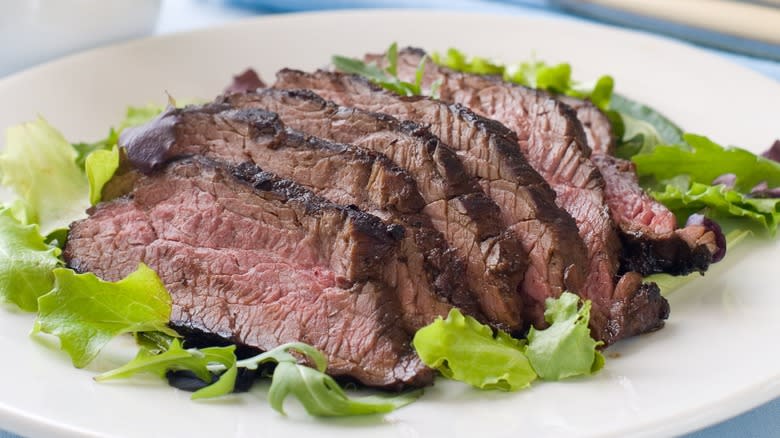
Tomahawks, ribeyes, and filet mignons are among the options you can choose from when ordering a steak -- but what about the world outside of beef? If you've never branched out, you may be surprised to learn that sampling ostrich steak is a great place to start. These birds, which can grow up to 9 feet tall and lay eggs that can weigh up to a whopping 3 pounds, produce nutritious meat that is full of vitamins and minerals.
Plus, while you probably wouldn't expect this flightless bird's meat to be that tasty, ostrich steaks are actually incredibly delicious. In fact, the U.S. Department of Agriculture classifies ostrich as red meat like beef due to its similar pH content and dark red hue -- unlike flesh from birds that can fly, like ducks, which is considered white meat. And unlike other poultry we consume, ostrich steak doesn't taste anything like chicken. Let's find out why you may want to give the meat of these birds, also known by their scientific name, Struthio camelus, a try.
Read more: Your Guide To The Different Cuts Of Steak
What Is Ostrich Steak?
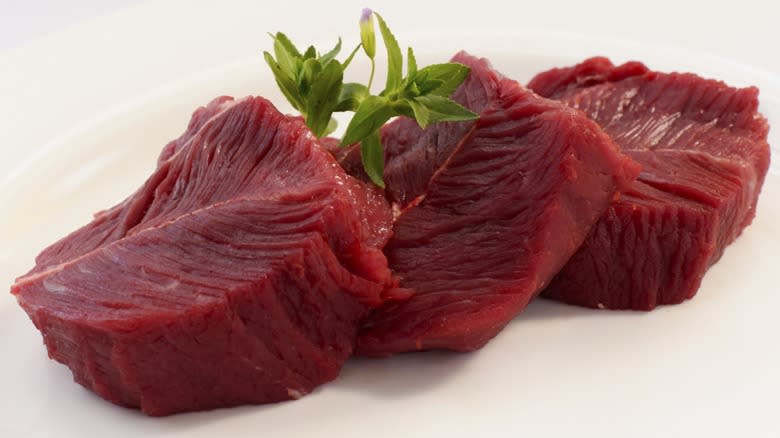
At first glance, you may mistake ostrich meat for beef. Raw, it has a dark red color, although the hue is a deep, wine-red shade, closer in appearance to venison than to the bright red color of an uncooked ribeye or filet mignon. In addition to steak, the bird's flesh can be made into sausage, hot dogs, burgers, and ground meat.
The flesh is primarily cut from the ostriches' thighs or hindquarters -- which, considering the height and weight of the birds (up to 250 pounds), provide a considerable amount of meat. While ostrich meat is technically classified as poultry, the birds are more closely related to emus and rheas than they are to chickens and turkeys.
When shopping for ostrich steak, the most popular cuts include: fan filets, which come from the inner thigh, resemble a London broil, and are the most tender, top striploin or top loins, which look like New York strip steak and can be cut into medallions, and tenderloins, which can be cooked in almost any way you'd like. Fan filets come in 6 or 8-ounce versions, while top loins are typically no larger than 1.5 pounds. Tenderloins, meanwhile, generally weigh up to 3 pounds.
Ostrich Steak Vs. Beef Steak
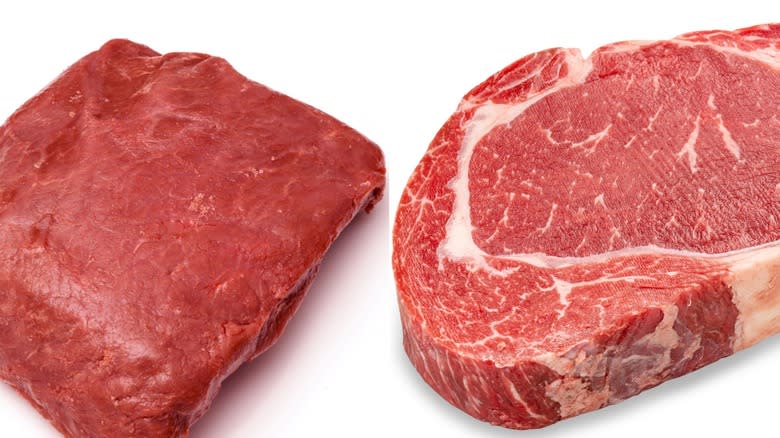
So we know that ostrich steak (left) looks more like venison than a typical cut of beef steak (right). The taste of the meat, however, is a different story. Although you may expect these birds to taste like chicken or turkey owing to their leaner meat, their flavor is much closer to cow steak -- which is one of the reasons they're so tasty, and why their flesh is considered closer to red meat than other types of poultry. In the same vein, you can cook an ostrich steak fairly similarly to how you would prepare a beef one.
The cuts of meat, however, generally come from different parts of these animals. While we typically eat the thighs and hindquarters of ostriches, cow steak can come from the chuck (right behind the neck), ribs, belly, back, and hindquarters -- so a much larger portion of the cow is used to make steak than the ostrich. While the birds' thighs may be tasty once cooked, beef thighs tend to be tough and full of gristle. But just like ostrich hindquarters are typically cut for consumption, this part of the cow can be used to make T-bone, sirloin, tenderloin, and flank steaks.
What Does Ostrich Steak Taste Like?
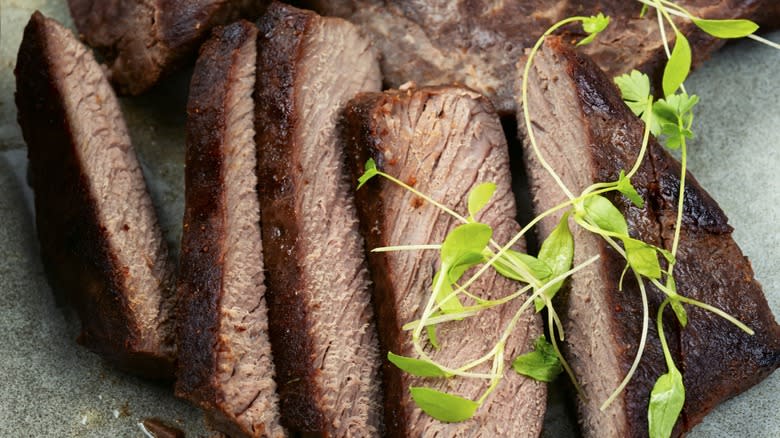
While ostrich steak tastes closer to beef steak than its poultry relatives, it's not an exact substitution flavor-wise. Ostrich meat is leaner than cow meat, the latter of which tends to have a higher fat content (aka more marbling) due to most of our cows' grain-based diets. So, while the taste is reminiscent of beef, its flavor is closer to that of grass-fed cows.
This means you'll get a nuttier, slightly blander flavor than what you'd expect with a sirloin or strip steak -- which isn't necessarily a bad thing, as you can add on whatever seasonings and sauces you'd like, and children may love the taste more than stronger-flavored protein options. But keep in mind that there's also a slightly gamey aspect to ostrich meat, so you may get notes of flavor that are similar to venison or veal as well.
As far as texture goes, ostrich is, again, very similar to beef -- but while the extra marbling adds a richer flavor to cow steak, you'll find more meat and less fat on these birds' steaks.
How To Cook With Ostrich Steak
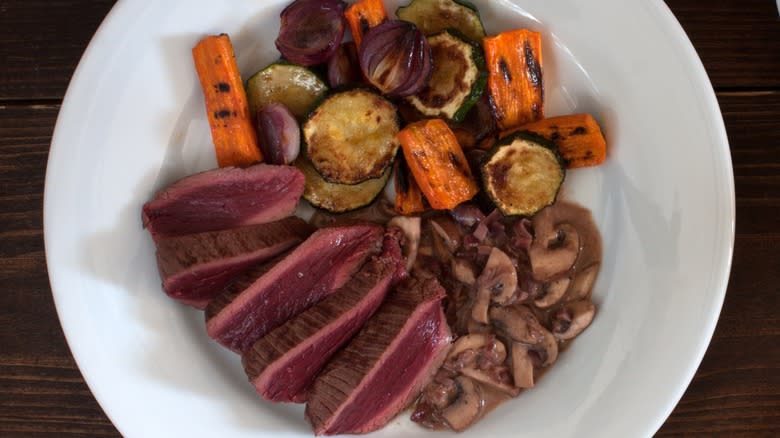
You can prepare ostrich steak much like you would beef steak. Cook it to your ideal level of doneness, although it's at its tastiest at medium-rare, and eating it well-done is discouraged as it tends to get very tough. Use the same visual cues you're familiar with to estimate if your ostrich meat is where you want it to be. For example, a medium-rare steak should be seared on the outside and red on the inside. But you can also use a meat thermometer to tell for sure, as 125 degrees Fahrenheit will indicate rare and 150 degrees Fahrenheit designates medium.
Unlike beef, however, the reduced amount of fat in these birds' meat means that your ostrich steaks won't shrink up during cooking, and you shouldn't have to drain any excess fat. Although this meat can be on the blander side, it effectively soaks up sauces and seasonings (like a coffee rub or sticky hoisin sauce), so you shouldn't have to let it marinate for long. But keep in mind that it will cook much quicker than a beef steak -- about four minutes on each side on the grill or in a cast iron skillet.
Much like cow steak, ostrich meat pairs beautifully with salt, black pepper, butter, garlic, wine, and herbs, while its slightly gamey flavor means it works well with mushrooms, mustard, and greens. Because it cooks so similarly to beef, you can even cut up your ostrich steak and add it to tacos, salads, stir-fries, and pasta.
Where To Buy Ostrich Steak

You can absolutely buy ostrich meat in the United States. As you're no doubt aware, however, it is much more rare than cow meat, meaning it can cost quite a bit more. Ostriches are native to Africa, although you can now find them being raised all over the world, particularly for their meat. According to American Ostrich Farms, a USDA census found that only 258 ostrich farms existed in the U.S. in 2012, partially because the birds were worth more when sold alive. That said, you can find these steaks at a variety of online retailers, and, because of their lean meat, you may even be able to find them at specialty health food stores.
Given its scarcity outside of Africa, don't be surprised if you find ostrich meat selling for steep prices. An entire fan can cost as much as $190, although a tenderloin may go for about $53, while a one-pound top loin may set you back just $36. When selecting a brand of ostrich steak, look for similar terminology to what you'd see with cow meat, such as birds free of antibiotics, hormones, and steroids.
Nutritional Information About Ostrich Steak
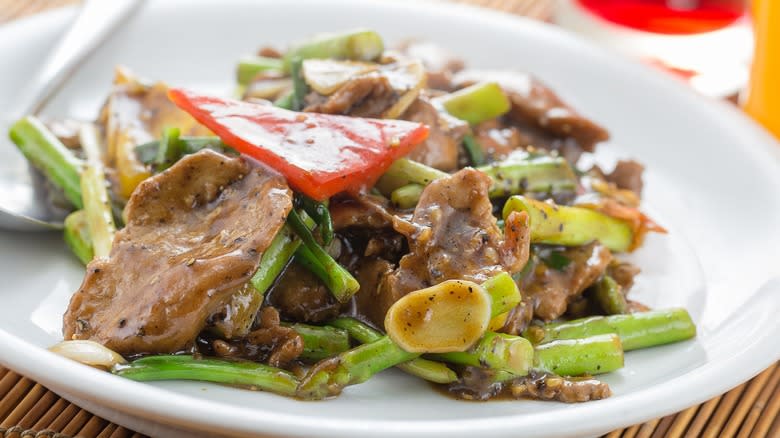
One of the biggest perks of choosing ostrich meat over other types is its high nutritional value. We mentioned that this bird's steak is leaner than beef, but, having just 1% fat, it's truly a lower fat option. Plus, ostrich meat is full of protein, vitamin B6, phosphorus, and manganese, and boasts more iron than lean ground beef.
Compared to chicken or turkey, it's lower in fat, calories, and cholesterol. It's also low in sodium and contains a "preferable fatty acid profile," according to a 2014 study published in the Journal of Applied Poultry Research, as it's high in polyunsaturated fatty acids but low in saturated fatty acids. In fact, the journal said, "Ostrich meat is considered an ideal red meat for individuals seeking healthier lifestyle," and is a more nutritious alternative to other types of meat for those with high blood pressure and anemia.
The possible downside of eating ostrich steak is that you open yourself up to the potential of food poisoning if you eat it undercooked, as with any other meat. However, American Ostrich Farms says it can be eaten rare or raw as tartare, and a 1997 review published in the Revue Scientifique et Technique claimed that no cases of ostrich meat with salmonella or other contaminants had been reported at the time the article was published. So, if you do get your hands on one of these uncommon steaks, you may want to give this tasty, lean beef alternative a try.
Read the original article on Tasting Table.

